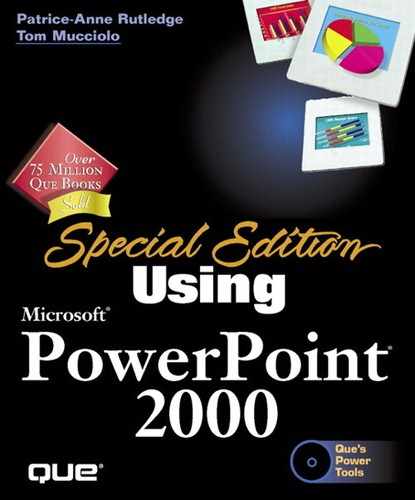Adding Shadow and 3D Effects
You can add shadow and 3D effects to objects including AutoShapes, WordArt, and clip art.
→ To learn more about adding an AutoShape object to a slide, see "Adding AutoShapes."
→ For details on how to effectively use WordArt to enhance your presentation, see "Inserting WordArt."
→ To learn what clip art images are available and how to use them, see "Inserting Clip Art."
 Select an object and click the Shadow button on the Drawing toolbar to display the Shadow palette, shown in Figure 12.25.
Select an object and click the Shadow button on the Drawing toolbar to display the Shadow palette, shown in Figure 12.25.
Figure 12.25. Shadows can add a dramatic effect to a presentation.

Choose the shadow style you want to apply from the available palette options.
Tip
![]()
 To immediately remove a shadow, click the Undo button. To remove a shadow later on, select the shadowed object, click the Shadow button on the Drawing toolbar, and choose No Shadow.
To immediately remove a shadow, click the Undo button. To remove a shadow later on, select the shadowed object, click the Shadow button on the Drawing toolbar, and choose No Shadow.
You can also customize the shadow by specifying its exact position and color. To do this, select Shadow Settings from the Shadow palette. The Shadow Settings toolbar displays, as described in Table 12.2. Figure 12.26 shows several objects with shadows.
→ To learn how to nudge an object to move it slightly, see "Nudging Objects."
→ For details on the effects of this dialog box, see "Using the Colors Dialog Box."
To add 3D effects, select the object you want to modify and click the 3D button on the Drawing toolbar. The 3D palette displays, illustrated in Figure 12.27.
![]() Choose the 3D style you want to apply from the available palette options.
Choose the 3D style you want to apply from the available palette options.
 Can't apply 3D effects?
See the Troubleshooting section at the end of the chapter.
Can't apply 3D effects?
See the Troubleshooting section at the end of the chapter.
Tip
To immediately remove a 3D effect, click the Undo button. To remove 3D later, select the object, click the 3D button on the Drawing toolbar, and choose No 3D.
![]()
![]() You can also customize the 3D effect by specifying its tilt, depth, direction, lighting, surface, and color. To do this, select 3D Settings from the 3D palette. The 3D Settings toolbar displays, described in Table 12.3.
You can also customize the 3D effect by specifying its tilt, depth, direction, lighting, surface, and color. To do this, select 3D Settings from the 3D palette. The 3D Settings toolbar displays, described in Table 12.3.
Figure 12.26. Get dramatic with shadows.

Figure 12.27. Get creative with 3D, but be sure your object doesn't become too distorted.

→ To learn more about the options available in this dialog box, see "Using the Colors Dialog Box."
Figure 12.28 shows several objects with 3D effects.

